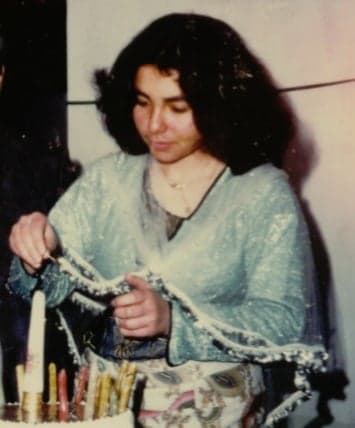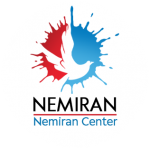Ali Karimi
At the beginning of the forties on 12th of March 1963 (1342 Iranian calendar) in the town of Mahabad, from a big family whom had connections to Kurdish Republic of Mahabad, a girl was born. She was named Narmin. Narmin was the sixth child in the family and second girl of lady Rana Zabihi and Mr Ibrahim Karimi.
Narmin was the youngest of six, and the most quiet one. She was loved by all her four brothers and sister. She grew with the love of her parents, and was popular amongst the children of the neighbourhood and at school.Since she was quiet, loving and calm natured she was liked by all neighbours and the school teachers. During the summer months the family would gather and whilst her brothers would socialise with guests, Narmin would be the one helping her mother with the cooking and hosting. During the final years of late Shah of Iran she joined the student movements and became a member in different councils and foundations.
The flood of the Iranian revolution sparked many young soulsinterests towards reading political articles as well as Marxist and leftist ideology. Narmin followed three of her brothers and became an active and energetic member of Komala. Later when the revolutionary guards attacked Kurdistan, one of her brothers became a Peshmerga and another responsible for the underground organisation in their town. Narmin became an even more active member in Komala. During the second invasion of Kurdistan by government forces and failing negotiations between the Kurdish delegates and government, Narmin and other young women, whom were known to be political activists, were forced to flee from Mahabad to neigbouring villages, for security reasons.

Mens hun var i landsbyene førte Narmins altruistiske natur henne til å begynne å støtte kvinner som slet.
Etter en betydelig militær operasjon i byen Mahabad så Narmin mange sårede og døde Peshmerga. Hun kunne ikke lenger stå og gå ut for å hjelpe de sårede. Hennes mor husker at da hun kom tilbake var det blod over hele kroppen hennes fra å behandle sårede Peshmerga. april 1983 (1362 iransk kalender) tidlig om morgenen kom en pickup av revolusjonære vakter tvang inn i huset deres og tok Narmin i forvaring. Selv om hennes far ba om nåde, ville dette ende opp med å bli siste gang Narmin så familiens hjem.
At the beginning of the Iranian revolution, the Islamic movement with Ayatollah Khomeini as their leader, had a strong grip on the minds of the young and unemployed in the major cities. They were often very religious and were convinced that the Kurds were “infidels.” Unaware of the struggles within the Kurdish communities, and brainwashed into thinking Kurds were beheading their prisoners, they were sent in thousands to defend Islam against Kurds. This coincided with the Iran Iraqi war. Most of those young men were misguided and had little idea of what they were doing in Kurdistan.
Unfortunately in the south of Kurdistan the Quran movement (a far right religious movement in Kurdistan) and other religious Kurdish establishments with the help of Hezbi Tudeh(a leftist Iranian political party), the Fedaian Khalq (another leftist party in Iran) and the so called 7 members of democratic Party who were previously members of Kurdistan Democratic Parti sided with the government. They begun to eradicate any dissent against Islamic revolution and they collaborated with the revolutionary guards and Iranian intelligence services in hunting down members of Komala and KDPI. Many of them went to Iran Iraqi war as so called patriots to defend their country. According to reports; Narmin was under torture more than 7 months in Mahabad and Oromie prison. She was detained by revolutionary guards at the time. On some occasions they would drive her around while she was blindfolded in an attempt to break her spirit down. They tried to take false confessions from her at the local tv station and every time a decision on her release would near, surprising confessions would emerge and her sentence would be increased.
At the time the clergies were repeatedly attacked by Kurdish peshmerga and they were unable to retaliate, they would instead avenge themselves on the civilians. Once they executed 59 young men as a form of revenge.
There has not been any judicial procedures in Narmin’s case. All that has been said about her has been told by her inmates. Her inmates recall on the 22 of October 1983 (1362 Iranian calendar) they found her bloody cloth, evidence of torture she endured. Some say she was executed on that morning and some say she died under torture.
On the 25 of September her older sister had gone to visit Narmin in prison. Her sister recalls Narmin sitting on a chair, in severe pain. Narmin was struggling to move without intense pain coming over her, and one of the guards told her to stay calm to not aggrevate her injuries. When her sister hugged her, she recalls Narmin writhing in pain. Narmin tried to hide her pain from her sister, she had told her sister she was alright. Her sister recalls her silent try, without complaint, disguising her agony.
Some days after, Narmin’s mother and sister visited the prison to see her. An old prison guard told them that Narmin was now free. They asked him where? When?
The man pointed at the sky and said her soul was free now. They realised that she was killed.
They later received the address of a cemetery marked for “infidels” and were told they could find her grave there. They were given her clothes and a box of sweets, as to celebrate that one more infidel was dead.
One late afternoon her parents and some other family members cautiously approached the cemetery and asked the digger to show them her grave. The guy was afraid of revolutionary guards who were patrolling the area. Her mother started to dig and finally she could feel a corpse but suddenly a light from a car interrupted them. They had to fill the grave in a rush and get away. Her mother said she was wrapped in a plastic bag but she had felt her hairs.
Her mother has suffered psychological illnesses ever since.
Her mother left Damghan where she and her husband were exiled. She later returned to Damghan and held a secret ceremony with other exile parents of Peshmerga who were living there.
The only thing left from Narmin is a handwritten testament dated 22 November that year. After 40 years since the detention and killing of Narmin, and thousands of others, remains unanswered and without closure. There is no understanding as to which court they were convicted, or the reasons for their executions.
The Islamic Republic has never listened to the complaints of relatives who have lost their loved ones. They continue suppressing the Kurdish people and stifling their cry for freedom. This is in the loving memory of Narmin and thousands of others who were unlawfully executed in Iranian prisons.
May their memory never be forgotten, and the mothers who have suffered so much get the recognition they deserve.

